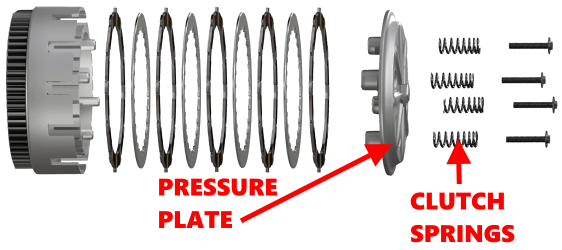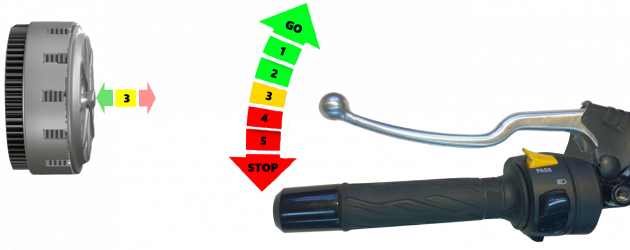FRICTION POINT
“The point where the friction created between the clutch plates begins to propel the motorcycle forward”
Why do we need a clutch and why is it so important to master when learning to ride a motorcycle? In simple terms, a clutch is the mechanical connection between the motorcycle’s engine and its transmission. With the motorcycle in first gear and the clutch fully engaged, typically the motorcycle’s speed would be far too fast to perform the required slow speed skills. We must learn how to use the friction point in such a manner that the subtle engaging and disengaging allows the rider commanding control at slow speeds. I should also mention here that anybody can ride a motorcycle fast. On our course, fast riding is a sure sign that our riders are not comfortable with balance and are not comfortable with the friction point. When our students ride at slow speeds, eyes up and in complete control of the clutch, we have done our job as instructors.
Motorcycle clutches are a bit different in design from an automobile clutch. The clutch pack consists of a Clutch Basket which is typically connected to the engine and an Inner Hub which is connected to the transmission. These spin independently from one another. There are a set of Friction Disks that key into the Clutch Basket and Steel Disks that key into the Inner Hub. You can see from the picture below how these connect.

A Pressure Plate sandwiches multiple Friction Disks and Steel Disks together using powerful Clutch Springs, essentially connecting them together into what is called a Clutch Pack. When the clutch lever is engaged by the rider’s left hand, it overcomes the pressure created by the Clutch Springs, thus reducing the friction and reducing power sent to the transmission. I should also mention here that, unlike an automobile clutch, typical motorcycle clutches are bathed in engine oil (wet clutches) and are better equipped to handle the heat generated by the additional friction. We often have difficulty with students with automobile manual transmission experience who learned to NOT “ride the clutch.” A motorcycle clutch is better designed for this.

To simplify this discussion, picture a clutch lever (operated by the motorcyclists left hand) having 5 positions. Position #5 (Stop) is when this lever is fully pulled into the handlebar like the picture below. If you ever get into trouble while riding, muscle memory should see us pulling in this clutch lever which will take all power away from the transmission.

Position #1 (Go) in the picture below is the “fully released position” that sees the engine 100% connected to the transmission. A motorcycle traveling down the road in 2nd, 3rd or higher gear and not in the act of changing gears, would typically be traveling with the clutch lever in the #1 position.

Our Friction Point (the purpose of this discussion) is the #3 clutch lever position. (Friction Zone)
“The point where the friction created between the clutch plates begins to propel the motorcycle forward”

When travelling at slow speeds in first gear, a rider should always “search for” and ride in the Friction Zone #3 position. Gently moving from the #4 to the #3, then #3 to the #2 position when power is needed. This allows us to be smooth with the motorcycle and always have power on hand when needed. Just remember, during slow speed riding, the clutch lever is not a light switch that is either “on” or “off.”